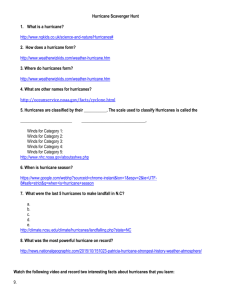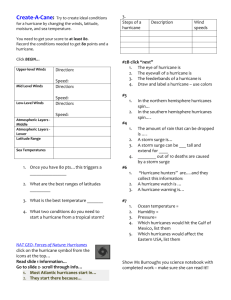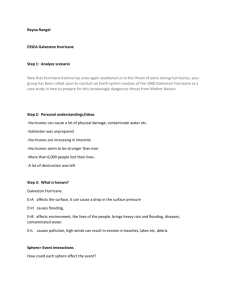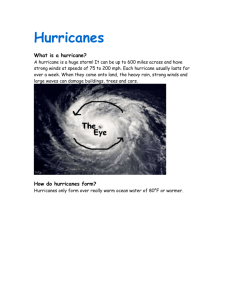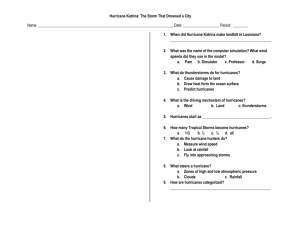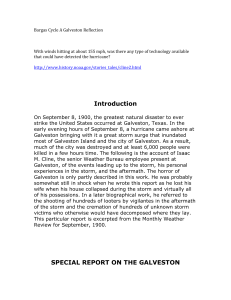Effects Of Hurricanes
advertisement
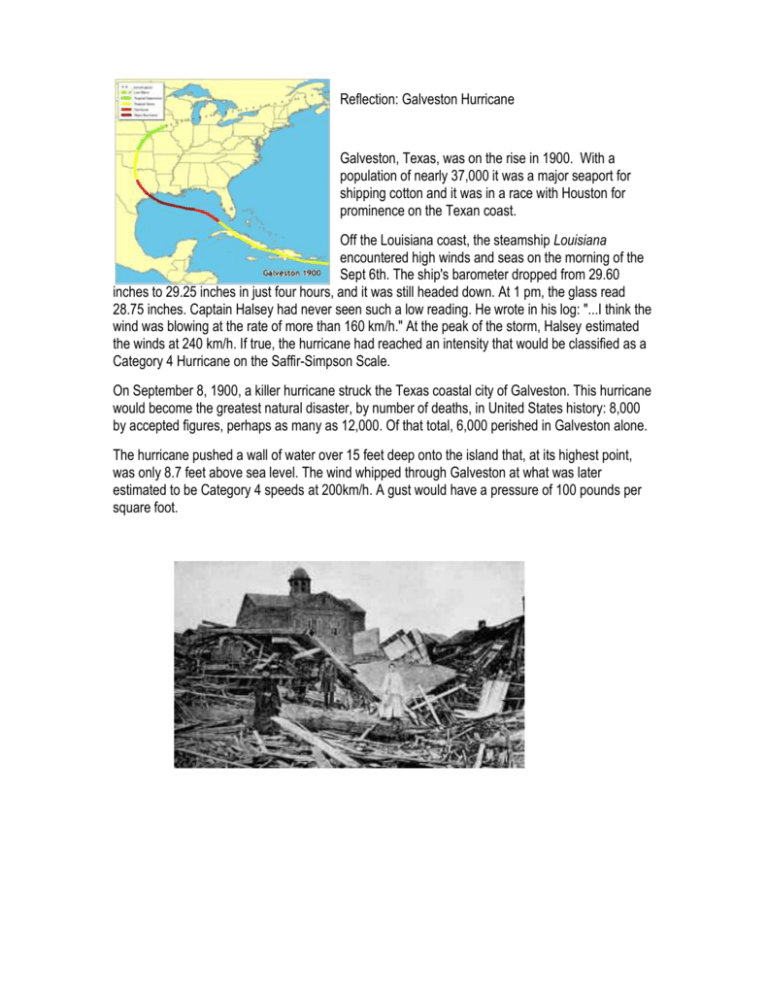
Reflection: Galveston Hurricane Galveston, Texas, was on the rise in 1900. With a population of nearly 37,000 it was a major seaport for shipping cotton and it was in a race with Houston for prominence on the Texan coast. Off the Louisiana coast, the steamship Louisiana encountered high winds and seas on the morning of the Sept 6th. The ship's barometer dropped from 29.60 inches to 29.25 inches in just four hours, and it was still headed down. At 1 pm, the glass read 28.75 inches. Captain Halsey had never seen such a low reading. He wrote in his log: "...I think the wind was blowing at the rate of more than 160 km/h." At the peak of the storm, Halsey estimated the winds at 240 km/h. If true, the hurricane had reached an intensity that would be classified as a Category 4 Hurricane on the Saffir-Simpson Scale. On September 8, 1900, a killer hurricane struck the Texas coastal city of Galveston. This hurricane would become the greatest natural disaster, by number of deaths, in United States history: 8,000 by accepted figures, perhaps as many as 12,000. Of that total, 6,000 perished in Galveston alone. The hurricane pushed a wall of water over 15 feet deep onto the island that, at its highest point, was only 8.7 feet above sea level. The wind whipped through Galveston at what was later estimated to be Category 4 speeds at 200km/h. A gust would have a pressure of 100 pounds per square foot. Summary Estimated Maximum Wind Speed: 200 km Estimated Storm Surge: 15 to 20 ft Lowest Observed Pressure: 28.53 inches (966 hPa) 27.49 inches Hg (931 hPa) Estimated SaffirSimpson Category: Estimated Number of Homes Destroyed Estimated Total Damage: Estimated Saffir-Simpson Category: 3,600-plus in Galveston. $25 to 50 million (in 1900 dollars); $500 million to $1 billion (in 2003 dollars) The official anemometer blew away after recording a sustained wind speed of 135 km/h and gust of 164 km/h. Galveston's highest point stood only 8.7 feet above sea level. The storm surge occurred at high tide. At the Galveston Weather Office At sea. (Some place the figure as high as 12,000). Effect of Hurricanes on the Biosphere What is the biosphere? The biosphere is the Earth’s thin zone of air, soil, and water in which life is supported. It ranges from about 10 km into the atmosphere to the depths of the deepest ocean floor. The biosphere has sustained life for hundreds of millions of years. The biosphere can be subdivided into various regions of growth patterns called biomes. (http://en.wikipedia.org/wiki/Biosphere) http://www.eoearth.org/article/Biosphere Sphere-Event A>H>E Warm tropical atmosphere heats seawater which evaporation and rises up. Combined with heat and energy in a low pressure centre, the warmed air continues to rise with moist air from the ocean taking its place to create more wind. A>E High-velocity winds blowing circularly around a low-pressure center. Wind pattern near ocean surface spiral air inward. This rising columns of air quickly form tropical thunderstorms, and the result is a potential “seed” for a tropical cyclone Event-Sphere E>A Decrease of barometric pressure E>A Increase moisture in air E>H: Increased turbidity, low dissolved Oxygen levels, increased sedimentation, salinity change E>A>L: High winds causing flooding/erosion and coastal degradation. Hurricanes bring with them huge amounts of rain. A big hurricane can dump dozens of inches of rain in just a day of two, much of it inland. That amount of rain can create inland flooding that can totally devastate a large area around the hurricane's center. Beach erosion and coastline damage (winds) High sustained winds cause structural damage. These winds can blow over trees and erode beaches (both by blowing sand and by blowing the waves into the beach). The prevailing winds of a hurricane push a wall of water, called a storm surge, in front of it. If the storm surge happens to synchronize with a high tide, it causes beach erosion and significant inland flooding. Hurricane winds often spawn tornadoes, which are smaller, more intense cyclonic storms that cause additional damage. This combination of winds, rain and flooding can level a coastal town and cause significant damage to cities. E>A>L>B High winds and increased rainfall can cause flooding/landslides endangering plants/animals E>B>A>H Increased Phytoplankton bloom cause absorption in carbon dioxide-plankton to die, drift to ocean floor allowing carbon to go to deep ocean. Hurricanes are an important part of the natural scheme of things because they help clean out species that might otherwise dominate an ecosystem. They also stir up much needed oxygen in oceanic "dead zones." They rekindle growth of opportunistic plants and provide critical food for animals. Their beneficial effects start before they ever get close to the shore. Hurricanes vertically mix up the water column which breaks up dead zones of oxygen-poor water. As hurricanes get closer to the shore, this mixing breaks up pockets of fresh water that are infested with bacteria from stream run-off. Along the coast, strong currents created by a hurricane's storm surge flush out sediment, rubble and weeds from coral reefs, and blast away fungal diseases that damage coral. The storms also draw up nutrient-rich water from below, increasing phytoplankton growth which provides a major food source for sea life. http://www.nasa.gov/centers/goddard/news/topstory/2004/0602hurricanebloom.html E>B>A Loss of vegetation. Decomposition releases millions of tons of carbon dioxide into atmosphere. Defoliation, deforestation affects levels of CO2 in atm. E>B: Loss of coral reefs, mangroves, forests, wetlands, sea grass meadows, loss of estuaries E>B: Loss of animal habitat. Species loss, change migration patters of birds and other wildlife. E>B: Damage to marine ecosystem: Kill and damage coral and sponge. Loss of invertebrates, sand-blasting of live tissue, smothering and burial of organisms, decreased fish population E>B>: Human Life, some of the physical after effects suffered by humans have come from drowning, hypothermia, diseases, violent crimes, carbon monoxide poisoning, suicides, and animal bites. Germs, cholera and other health related drinking contaminated water or returning to moldy homes caused problems. E>L>B Plants and animals that once lived on the beach are now homeless and have to seek shelter elsewhere. Erosion can also affect seagrass. Seas grass acts as a barrier between the mainland and the coastline and has developed into an extremely productive system and is critical to the survival of many species such as snail, crustaceans, bivalves, fish, sea turtles, marine mammals and birds. Hurricanes can cause materials from adjacent islands to be swept up and deposited, burying seagrass. The loss of edible seagrass can affect many birds, such as the egrets, herons, gulls and Red head duck, and pelicans. It can affect their nesting habits and breeding ground. E>B: Pollution due to toxic chemicals , garbage accumulation, contamination, eutrophication http://en.wikipedia.org/wiki/Eutrophication E>B: Hurricane winds can be so fierce and rough that it can force ocean water up to the mouth of rivers, lakes, and streams and cause cross water contamination to occur. Animals living in fresh water will not survive when the salt water contaminates their natural environment. Severe loss of freshwater. Untreated human sewage could be diverted into the nearby water systems. . Resources 1. http://www.ec.gc.ca/ouragans-hurricanes/default.asp?lang=En&n=77977664-1 2. http://kids.mtpe.hq.nasa.gov/archive/hurricane/index.html 3. http://www.nasa.gov/centers/goddard/news/topstory/2004/0817trmmhurricane.html 4. http://www.islandnet.com/~see/weather/events/1900hurr.htm 5. http://www.nasa.gov/mission_pages/hurricanes/main/index.html 6. http://www.cpo.noaa.gov/education/hurricanes/hurricane_basics.pdf

